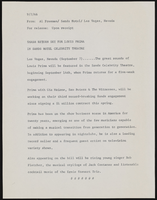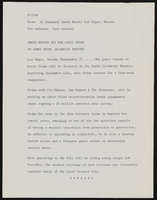Search the Special Collections and Archives Portal
Search Results

Interview with Katsumi Furitsu, with Janet Gordon, May 13, 2005
Date
2005-05-13
Archival Collection
Description
Narrator affiliation: Physician and international anti-nuclear activist
Text
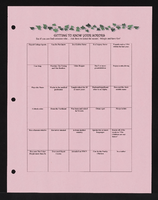
Alpha Kappa Alpha Sorority, Theta Theta Omega Chapter sisterly relations ice breakers
Date
2005
Archival Collection
Description
From the Alpha Kappa Alpha Sorority, Incorporated, Theta Theta Omega Chapter Records (MS-01014) -- Chapter records file.
Text
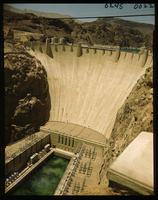
Film transparency of the face of Hoover (Boulder) Dam, taken from the downstream side of the dam on the Arizona side, May, 1947
Date
1947-05
Archival Collection
Description
The face of Hoover (Boulder) Dam, taken from the downstream side of the dam on the Arizona side, May, 1947. The intake towers are visible in the background. The hydroelectric generators are visible in the foreground. During the years of lobbying leading up to the passage of legislation authorizing the dam in 1928, Hoover Dam was originally referred to "Boulder Dam" or as "Boulder Canyon Dam", even though the proposed site had shifted to Black Canyon. The Boulder Canyon Project Act of 1928 (BCPA) never mentions a proposed name or title for the dam. When Secretary Wilbur spoke at the ceremony starting the building of the railway between Las Vegas and the dam site on September 17, 1930, he named the dam "Hoover Dam", citing a tradition of naming dams after Presidents, though none had been so honored during their terms of office. After Hoover's election defeat in 1932 and the accession of the Roosevelt administration, Secretary Ickes ordered on May 13, 1933 that the dam be referred to as "Boulder Dam". In the following years, the name "Boulder Dam" failed to fully take hold, with many Americans using both names interchangeably and map makers divided as to which name should be printed. In 1947, a bill passed both Houses of Congress unanimously restoring the name to "Hoover Dam".
Image
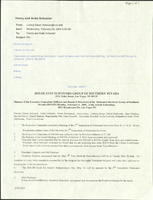
Dick Hannah's records from Carl Byoir & Associates, 1946-1976
Level of Description
Series
Scope and Contents
This series dates from 1946-1976 and contains correspondence, memos, newsletters, expenses, distribution lists, directories, and press releases generated by Dick Hannah and the staff of Carl Byoir & Associates, a public relations firm hired by Howard Hughes to oversee public relations for himself and his companies.
Archival Collection
Howard Hughes Public Relations Reference Files
Archival Component
Pagination
Refine my results
Content Type
Creator or Contributor
Subject
Archival Collection
Digital Project
Resource Type
Year
Material Type
Place
Language
Records Classification

